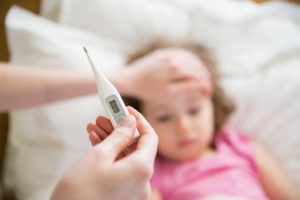The croup cough, also known as pseudo croup, is a respiratory infection that almost always occurs only in children. What are the causes, for the agonizing, barking cough, which sometimes requires hospital therapy?
How can you recognize a croup attack? Read now what the symptoms and treatments are.
Croup Cough: Childhood Illness That Also Affects Adults
The croup cough is the classic symptom of pseudocroup. This is a respiratory infection, or more precisely laryngitis, which is triggered by viruses. Babies and young children are almost always affected, and the cough is particularly agonizing for them.
The good news is that croup cough almost always goes away on its own. In some cases, however, inpatient therapy in a hospital is unavoidable. In the following, you will learn what symptoms croup brings and when it is time to consult the doctor.
Table of contents
Pseudocroup – An Overview Of The Disease
Croup is an infection of the larynx. The area above the glottis is affected. The trigger is usually cold viruses. If the upper respiratory tract is affected, the disease causes symptoms that are more pronounced than classic bronchitis symptoms.
The throat, nose and neck are lined with mucous membranes that swell massively. There are also spasms in the trachea.
These processes in the body cause the classic symptoms, first and foremost the croup cough. This is not a normal cough, even if the signs initially seem like bronchitis symptoms. Croup cough occurs in attacks, it is dry and sounds barking.
Like the classic cold, croup occurs almost exclusively in the winter months. Those affected are primarily children between the ages of one and five. Boys are statistically more often affected than girls. If pseudo croup occurs more frequently or if children fall ill outside the classic age of onset, they are often prone to asthma.
Is Pseudocroup The Same As Croup?
Confusion often occurs between croup and pseudo croup. However, real croup is a severe inflammation of the larynx and occurs only with Diptheria. However, due to continuous vaccination protection, real croup is extremely rare. Nowadays, when croup is mentioned, it is usually used as a synonym for pseudo croup.
What To Do When An Attack Of Pseudocroup Occurs?
In the acute state, laryngitis is manifested by symptoms that occur repeatedly in episodes. An attack often comes out of nowhere and can be severe. Possible triggers include.
- Dry room air.
- Breathing through the mouth.
- Deep breathing.
Sometimes laryngitis manifests itself through symptoms such as runny nose, stuffy nose, and breathing problems. In this case, children breathe through the mouth, which in turn leads to further swelling of the mucous membranes. In addition, mouth breathing not infrequently leads to a croup cough attack.
First Aid Tips For Acute Croup Cough
There are some relief methods for alleviating an acute attack of croup. Above all, cold plays a major role here.
- Open windows and breathe in cool, fresh air.
- Drink cool drinks with ice cubes.
- Soothing words or music.
- Allow ice cubes to melt slowly in the mouth.
An acute attack can also be relieved by moist air. Nebulizers are used here, as are damp towels hung over the radiator.
Attention: The Most Common Symptoms Of Croup Cough
In every child, laryngitis expresses symptoms, but they do not always occur simultaneously. Mainly due to the strong cough, the clinical picture often reminds of bronchitis symptoms, but it is not comparable with it. Bronchitis symptoms are characterized only by moist cough with sputum, while croup cough is dry and barking.
One of the main symptoms of pseudo croup is croup cough. It is very dry and occurs largely at night. The reason for this is that cortisol levels are lowered at night. Cortisol is an anti-inflammatory hormone that can relieve laryngitis symptoms during the day.
Many sufferers experience acute shortness of breath at night. The symptom may also occur during the day, but usually with a marked increase toward the evening hours. If the shortness of breath is very severe, cyanosis may develop.
In this case, the body no longer receives sufficient oxygen. It comes to a tachycardia https://flexikon.doccheck.com/de/Tachykardie and as a result quickly to panic reactions in the child.
Other Symptoms That Can Occur With Croup Cough Are
- Hoarseness and difficulty speaking.
- Problems with breathing.
- Whistling, squeaking breathing sounds.
- Pronounced feeling of weakness.
- Fever.
Pseudocroup often develops from a cold. Classic bronchitis symptoms are therefore also counted among the initial symptoms of croup cough.
Four Stages Of Illness In Croup Cough
Depending on the severity of the laryngitis symptoms, there are four stages into which croup cough is divided.
- 1 stage: hoarseness, barking croup cough.
- 2 stage: collapsing chest when breathing, loud breathing sounds.
- 3 stage: tachycardia, pallor, panic reactions, shortness of breath.
- 4 stage: severe shortness of breath, tachycardia, strong breathing sounds, cyanosis, clouding of consciousness.
This Is How The Dangerous Croup Cough Can Develop
In most cases, cold viruses are to blame for pseudocroup. These include:
- Influenza A and B viruses.
- Rhinoviruses.
- Adenoviruses.
- RS viruses.
- Metapneumo viruses.
- Parainfluenza viruses.
In exceptional cases, chickenpox, measles, and herpes simplex viruses can also act as triggers. The viral infection of all mucous membranes causes swelling of the vocal cords. Sometimes classic bronchitis symptoms such as mucus in the bronchial tubes appear first. The dry croup cough then develops only in the course.
Warning: These Factors Aggravate Croup Cough
Babies and young children have very narrow airways. If these narrow, it quickly becomes life-threatening. If you suspect croup cough in your child, it is important to see the pediatrician immediately.
If the disease has already been diagnosed, the symptoms can be significantly aggravated by environmental influences. These include, above all, cigarette smoke and exhaust fumes. Windows that lead directly to a street should therefore be opened mainly at night.
How The Doctor Diagnoses Croup Cough
Pseudocroup is often diagnosed by the pediatrician at first glance. The characteristic cough provides the decisive clue. Since many children also produce whistling sounds when breathing, further tests are rarely needed. The medical history helps the doctor to classify the complaints.
A scoring scheme can be used to determine the severity of the croup illness. Symptoms such as shortness of breath, cyanosis, breath sounds and clouding of consciousness are included here.
The physician classifies croup cough into a mild, moderate or severe form. Severe croup cough must be treated in the hospital because it is associated with life-threatening respiratory distress.
Differentiation Between Croup Cough And Epiglottitis
Epiglottis (epiglottitis) is a life-threatening inflammation. The symptoms are similar to croup cough, but the disease is more dangerous. During a throat examination, the doctor can tell if it is laryngitis or epiglottis. Only if the diagnosis cannot be made beyond doubt by sight is a chest x-ray is taken.
Help In A Time Of Need: This Is How Croup Cough Is Treated
In many cases, croup cough is mild and treatment is done at home. It is recommended for the patient to sleep with the window open. In order not to provoke bronchitis symptoms, tobacco smoke should be avoided in the vicinity.
The pediatrician prescribes cortisone preparations, against the massive swelling of the mucous membrane. If fever occurs, it can be reduced with paracetamol or Nurofen.
If it is not a mild form of croup, the affected child is usually admitted to hospital as an inpatient. Professional help is especially important if respiratory distress occurs.
In the hospital, doctors use cortisone, epinephine and adrenaline. This combination of active ingredients causes the mucous membranes to swell. If acute respiratory distress occurs, oxygen can be supplied via a breathing mask.










